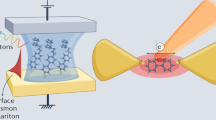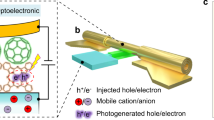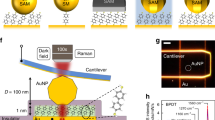Abstract
Molecular electronic control over plasmons offers a promising route for on-chip integrated molecular plasmonic devices for information processing and computing. To move beyond the currently available technologies and to miniaturize plasmonic devices, molecular electronic plasmon sources are required. Here, we report on-chip molecular electronic plasmon sources consisting of tunnel junctions based on self-assembled monolayers sandwiched between two metallic electrodes that excite localized plasmons, and surface plasmon polaritons, with tunnelling electrons. The plasmons originate from single, diffraction-limited spots within the junctions, follow power-law distributed photon statistics, and have well-defined polarization orientations. The structure of the self-assembled monolayer and the applied bias influence the observed polarization. We also show molecular electronic control of the plasmon intensity by changing the chemical structure of the molecules and by bias-selective excitation of plasmons using molecular diodes.
This is a preview of subscription content, access via your institution
Access options
Subscribe to this journal
Receive 12 print issues and online access
$209.00 per year
only $17.42 per issue
Buy this article
- Purchase on Springer Link
- Instant access to full article PDF
Prices may be subject to local taxes which are calculated during checkout





Similar content being viewed by others
References
Barnes, W. L., Dereux, A. & Ebbesen, T. W. Surface plasmon subwavelength optics. Nature 424, 824–830 (2003).
Lal, S., Link, S. & Halas, N. J. Nano-optics from sensing to waveguiding. Nature Photon. 1, 641–648 (2007).
Gramotnev, D. K. & Bozhevolnyi, S. I. Plasmonics beyond the diffraction limit. Nature Photon. 4, 83–91 (2010).
Schuller, J. A. et al. Plasmonics for extreme light concentration and manipulation. Nature Mater. 9, 193–204 (2010).
Koller, D. M. et al. Organic plasmon-emitting diode. Nature Photon. 2, 684–687 (2008).
Neutens, P., Lagae, L., Borghs, G. & Dorpe, P. V. Electrical excitation of confined surface plasmon polaritons in metallic slot waveguides. Nano Lett. 10, 1429–1432 (2010).
Fan, P. et al. An electrically-driven GaAs nanowire surface plasmon source. Nano Lett. 12, 4943–4947 (2012).
Huang, K. C. Y. et al. Electrically driven subwavelength optical nanocircuits. Nature Photon. 8, 244–249 (2014).
Costantini, D. et al. In situ generation of surface plasmon polaritons using a near-infrared laser diode. Nano Lett. 12, 4693–4697 (2012).
Walters, R. J., van Loon, R. V. A., Brunets, I., Schmitz, J. & Polman, A. A silicon-based electrical source of surface plasmon polaritons. Nature Mater. 9, 21–25 (2009).
Rai, P. et al. Electrical excitation of surface plasmons by an individual carbon nanotube transistor. Phys. Rev. Lett. 111, 026804 (2013).
Lambe, J. & McCarthy, S. L. Light emission from inelastic electron tunneling. Phys. Rev. Lett. 37, 923 (1976).
Dawson, P., Walmsley, D. G., Quinn, H. A. & Ferguson, A. J. L. Observation and explanation of light-emission spectra from statistically rough Cu, Ag, and Au tunnel junctions. Phys. Rev. B 30, 3164 (1984).
Ushioda, S. Light emission associated with tunneling phenomena. J. Lumin. 47, 131–136 (1990).
Berndt, R., Gimzewski, J. K. & Johansson, P. Inelastic tunneling excitation of tip-induced plasmon modes on noble-metal surfaces. Phys. Rev. Lett. 67, 3796 (1991).
Schull, G., Néel, N., Johansson, P. & Berndt, R. Electron–plasmon and electron–electron interactions at a single atom contact. Phys. Rev. Lett. 102, 057401 (2009).
Chen, C., Bobisch, C. A. & Ho, W. Visualization of Fermi's Golden Rule through imaging of light emission from atomic silver chains. Science 325, 981–985 (2009).
Wang, T., Boer-Duchemin, E., Zhang, Y., Comtet, G. & Dujardin, G. Excitation of propagating surface plasmons with a scanning tunnelling microscope. Nanotechnology 22, 175201 (2011).
Bharadwaj, P., Bouhelier, A. & Novotny, L. Electrical excitation of surface plasmons. Phys. Rev. Lett. 106, 226802 (2011).
Qiu, X. H., Nazin, G. V. & Ho, W. Vibrationally resolved fluorescence excited with submolecular precision. Science 299, 542–546 (2003).
Rossel, F., Pivetta, M., Patthey, F. & Schneider, W. D. Plasmon enhanced luminescence from fullerene molecules excited by local electron tunneling. Opt. Express 17, 2714–2721 (2009).
Reecht, G. et al. Electroluminescence of a polythiophene molecular wire suspended between a metallic surface and the tip of a scanning tunneling microscope. Phys. Rev. Lett. 112, 047403 (2014).
Schneider, N. L., Lü, J. T., Brandbyge, M. & Berndt, R. Light emission probing quantum shot noise and charge fluctuations at a biased molecular junction. Phys. Rev. Lett. 109, 186601 (2012).
Geng, F. et al. Modulation of nanocavity plasmonic emission by local molecular states of C60 on Au(111). Opt. Express 20, 26725–26735 (2012).
Lutz, T. et al. Molecular orbital gates for plasmon excitation. Nano Lett. 13, 2846–2850 (2013).
Shafir, D. et al. Resolving the time when an electron exits a tunnelling barrier. Nature 485, 343–346 (2012).
Novotny, L. & van Hulst, N. Antennas for light. Nature Photon. 5, 83–90 (2011).
Kern, J. et al. Electrically driven optical antennas. Nature Photon. 9, 582–586 (2015).
Nijhuis, C. A., Reus, W. F. & Whitesides, G. M. Molecular rectification in metal–SAM–metal oxide–metal junctions. J. Am. Chem. Soc. 131, 17814–17827 (2009).
Nerngchanmnong, N. et al. The role of van der Waals forces in the performance of molecular diodes. Nature Nanotech. 8, 113–118 (2013).
Jeong, H. et al. Redox-induced asymmetric electrical characteristics of ferrocene–alkanethiolate molecular devices on rigid and flexible substrates. Adv. Funct. Mater. 24, 2472–2480 (2014).
Tao, N. J. Electron transport in molecular junctions. Nature Nanotech. 1, 173–181 (2006).
Galperin, M. & Nitzan, A. Molecular optoelectronics: the interaction of molecular conduction junctions with light. Phys. Chem. Chem. Phys. 14, 9421–9438 (2012).
Tan, S. F. et al. Quantum plasmon resonances controlled by molecular tunnel junctions. Science 343, 1496–1499 (2014).
Wan, A., Jiang, L., Sangeeth, C. S. S. & Nijhuis, C. A. Reversible soft top-contacts to yield molecular junctions with precise and reproducible electrical characteristics. Adv. Funct. Mater. 24, 4442–4456 (2014).
Chiechi, R. C., Weiss, E. A., Dickey, M. D. & Whitesides, G. M. Eutectic gallium–indium (EGaIn): a moldable liquid metal for electrical characterization of self-assembled monolayers. Angew. Chem. Int. Ed. 47, 142–144 (2007).
Reus, W. F., Thuo, M. M., Shapiro, N. D., Nijhuis, C. A. & Whitesides, G. M. The SAM, not the electrodes, dominates charge transport in metal-monolayer//Ga2O3/gallium-indium eutectic junctions. ACS Nano 6, 4806–4822 (2012).
Simeone, F. C. et al. Defining the value of injection current and effective electrical contact area for EGaIn-based molecular tunneling junctions. J. Am. Chem. Soc. 135, 18131–18144 (2013).
Wimbush, K. S. et al. Bias induced transition from an ohmic to a non-ohmic interface in supramolecular tunneling junctions with Ga2O3/EGaIn top electrodes. Nanoscale 6, 11246–11258 (2014).
Jiang, L., Sangeeth, C. S. S., Wan, A., Vilan, A. & Nijhuis, C. A. Defect scaling with contact area in EGaIn-based junctions: impact on quality, Joule heating, and apparent injection current. J. Phys. Chem. C 119, 960–969 (2015).
Salomon, A. et al. Comparison of electronic transport measurements on organic molecules. Adv. Mater. 15, 1881–1890 (2003).
Akkerman, H. B. & de Boer, B. Electrical conduction through single molecules and self-assembled monolayers. J. Phys. Condens. Matter 20, 013001 (2008).
Nazin, G. V., Wu, S. W. & Ho, W. Tunneling rates in electron transport through double-barrier molecular junctions in a scanning tunneling microscope. Proc. Natl Acad. Sci. USA 102, 8832–8837 (2005).
Yuan, L. et al. Controlling the direction of rectification in a molecular diode. Nature Commun. 6, 6324 (2015).
Sangeeth, C. S. S., Wan, A. & Nijhuis, C. A. Equivalent circuits of a self-assembled monolayer-based tunnel junction determined by impedance spectroscopy. J. Am. Chem. Soc. 136, 11134–11144 (2014).
Frantsuzov, P., Kuno, M., Jankó, B. & Marcus, R. A. Universal emission intermittency in quantum dots, nanorods and nanowires. Nature Phys. 4, 519–522 (2008).
Wassel, R. A., Fuierer, R. R., Kim, N. & Gorman, C. B. Stochastic variation in conductance on the nanometer scale: a general phenomenon. Nano Lett. 3, 1617–1620 (2003).
Troisi, A. & Ratner, M. A. Molecular signatures in the transport properties of molecular wire junctions: what makes a junction ‘molecular’. Small 2, 172–181 (2006).
Hutchison, J. A. et al. A surface-bound molecule that undergoes optically biased Brownian rotation. Nature Nanotech. 9, 131–136 (2014).
Haag, R., Rampi, M. A., Holmlin, R. E. & Whitesides, G. M. Electrical breakdown of aliphatic and aromatic self-assembled monolayers used as nanometer-thick organic dielectrics. J. Am. Chem. Soc. 121, 7895–7906 (1999).
McConnell, H. M. Intramolecular charge transfer in aromatic free radicals. J. Chem. Phys. 35, 508–515 (1961).
Song, H. W., Lee, H. Y. & Lee, T. H. Intermolecular chain-to-chain tunneling in metal–alkanethiol–metal junctions. J. Am. Chem. Soc. 129, 3806–3807 (2007).
Aizpurua, J., Apell, S. P. & Berndt, R. Role of tip shape in light emission from the scanning tunneling microscope. Phys. Rev. B 62, 2065–2073 (2000).
Acknowledgements
The authors acknowledge support from the National Research Foundation (NRF) under the Competitive Research Programme (CRP) (award no. NRF-CRP 8-2011-07). The authors also acknowledge NRF for supporting this research under the Prime Minister’s Office, Singapore under its Medium Sized Centre Programme. N.T. acknowledges the Institute of Materials Research and Engineering for providing financial support (grant no. IMRE/15-1P1105). H.S.C. acknowledges support from the A*STAR Computational Resource Centre through the use of its high-performance computing facilities. S.S. thanks J. Enderlein (Georg-August-Universität Göttingen) for discussions on developing the Matlab code to calculate the defocused images from any arbitrary far-field radiation pattern.
Author information
Authors and Affiliations
Contributions
C.A.N. and N.T. conceived and designed the experiments. W.D. fabricated the samples. W.D. and T.W. performed the wide-field experiments and analysed the data. W.D., T.W., R.L. and N.T. performed the confocal experiments. H.S.C., L.W., S.S. and W.K.P. performed the theoretical calculations. L.J.W. synthesized S-OPE-Fc molecules. T.W., N.T. and C.A.N. wrote the manuscript. All authors discussed the results and commented on the manuscript.
Corresponding authors
Ethics declarations
Competing interests
The authors declare no competing financial interests.
Supplementary information
Supplementary information
Supplementary information (PDF 4745 kb)
Supplementary information
Supplementary Movie 1 (AVI 1502 kb)
Rights and permissions
About this article
Cite this article
Du, W., Wang, T., Chu, HS. et al. On-chip molecular electronic plasmon sources based on self-assembled monolayer tunnel junctions. Nature Photon 10, 274–280 (2016). https://doi.org/10.1038/nphoton.2016.43
Received:
Accepted:
Published:
Issue Date:
DOI: https://doi.org/10.1038/nphoton.2016.43
This article is cited by
-
A nano-plasmonic HMIM waveguide based concurrent dual-band BPF using circular ring resonator
Optoelectronics Letters (2024)
-
Near-field and photocatalytic properties of mono- and bimetallic nanostructures monitored by nanocavity surface-enhanced Raman scattering
Nano Research (2023)
-
Dielectric polymer grafted electrodes enhanced aqueous supercapacitors
Nano Research (2023)
-
Plasmonic phenomena in molecular junctions: principles and applications
Nature Reviews Chemistry (2022)
-
Investigation of electronic excited states in single-molecule junctions
Nano Research (2022)



